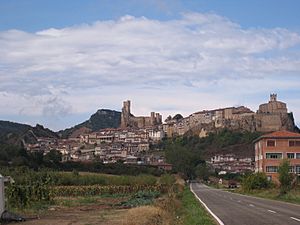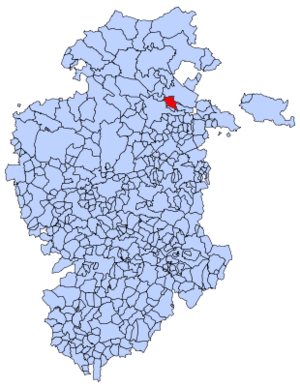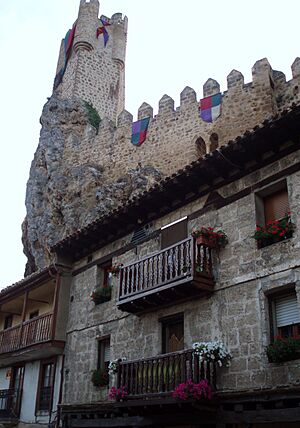Frías, Province of Burgos facts for kids
Quick facts for kids
Frías
|
|
|---|---|
|
Municipality and city
|
|
| Ciudad de Frías | |

Panoramic view of Frías, 2007
|
|

Municipal location of Frías in Burgos province
|
|
| Country | Spain |
| Autonomous community | |
| Province | |
| Comarca | Las Merindades |
| Area | |
| • Total | 32 km2 (12 sq mi) |
| Elevation | 555 m (1,821 ft) |
| Population
(2018)
|
|
| • Total | 254 |
| • Density | 7.94/km2 (20.6/sq mi) |
| Time zone | UTC+1 (CET) |
| • Summer (DST) | UTC+2 (CEST) |
| Postal code |
09211
|
| Website | http://www.ciudaddefrias.es/ |
| Frías is the smallest settlement with the city title in Spain | |
Frías is a small, historic city in northern Spain. It's located in the province of Burgos, within the region of Castile and León. In 2010, only about 275 people lived there, making it the smallest place in Spain to be called a "city." Frías got this special title in 1435.
This medieval town sits on a hill overlooking the Ebro River. Its location was very important in the past. It was a key spot for crossing the Ebro River on routes leading to the Cantabrian Sea. Today, Frías is a popular place for tourists to visit. It has an amazing castle and a very old bridge from the 12th century. The town also has two convents and two churches, including the beautiful Gothic-style San Vitores church.
Geography
Where is Frías Located?
Frías is about 80 kilometers (50 miles) northeast of Burgos, a larger city. It is right on the banks of the Ebro River. The area around Frías covers about 29.37 square kilometers (11.34 square miles).
Frías shares its borders with several other towns:
| Northwest: Cillaperlata | North: Valle de Tobalina | Northeast: Valle de Tobalina |
| West: Oña | East: Partido de la Sierra en Tobalina | |
| Southwest Oña | South: Partido de la Sierra en Tobalina | Southeast: Oña |
Main Attractions
Frías is famous for its historical buildings and unique architecture. Many of these sites are very old and tell stories of the past.
- Frias Castle: This castle was built between the 12th and 15th centuries.
- Hanging Houses: These are unique houses that seem to hang from the side of the hill.
- The Medieval Bridge: A very old bridge with a defensive tower that crosses the Ebro River.
- San Vitores Church: A beautiful Gothic church from the 13th-14th century.
History
Early History of Frías
The name Frías comes from the cold water that flowed from the mountains into the Tobalina Valley. The town was first mentioned in the late 9th century. After the year 1000, it became part of the Kingdom of Navarre, which was located in Burgos. Frías often grew and developed even during times of war.
Changes in Control
As part of Navarre, Frías was controlled by King Sancho III the Great. In 1504, Navarre lost a battle and Frías became part of Castile again. Later, Frías was controlled by important figures like Diego Lopez de Haro in the late 11th century and King Alfonso VIII in 1200.
Growth and City Status
After 1201, King Alfonso VIII gave Frías special laws. These laws allowed the townspeople to choose their own mayor and helped their economy grow. Frías became very successful because of these new freedoms. In 1435, King John II gave Frías the important title of "city."
The Fiesta del Capitán
In the summer of 1450, an army of 1500 men from Balmaseda attacked Frías. But the people of Frías worked together and successfully fought off the army. This brave act is celebrated every year with an event called the Fiesta del Capitán. Frías continued to experience periods of being controlled by others and then gaining freedom. Finally, in 1811, a system called feudalism was ended across all of Spain, giving more freedom to towns like Frías.
Heritage
The old part of Frías is a protected historical site. It has kept its original layout and special building styles.
The Hanging Houses
These unique houses have a ground floor and two or three more floors. They are built very close together, creating streets at different levels. Some of these houses even hang from the side of the rock! They are made of limestone walls with a wooden structure.
You can find these houses on the streets that go up the hill towards Velasco's Castle and San Vicente church. A wall partly surrounds the old town. Two old archways, called Puerta del Postigo and Puerta de Medina, are still standing. These arches are also made of limestone and wood, which helps them blend in with the rock.
Salazar Palace and Barracks
This building is in Alfonso VIII Square, near the castle. It was once the palace of the Salazar family. You can see their family symbol, a coat of arms with thirteen stars, above the door. Later, it was used as army barracks. Today, it is the Tourism Office for Frías.
Roman Road
An important Roman road used to pass through Frías. This road connected the Castilian plateau with northern Spain. It crossed the Ebro River at a shallow point about 500 meters east of the medieval bridge. Frías was also the starting point for another Roman road that went to La Rioja.
The Medieval Bridge
Frías' medieval bridge is 143 meters (469 feet) long and has 9 arches. It was built in a Romanic style. In the 14th century, a defensive tower was added to the center of the bridge. This tower had arrow-holes and battlements, which are parts of a castle wall used for defense. The tower also collected tolls, a fee for crossing the bridge.
The Jewish Quarter
The Jewish quarter in Frías was an important part of the town, though it was not well-known until recently. Records show Jewish residents living here in the 14th century, and even earlier. For example, in 1387, a person named Nahamías was listed as a resident. The Jewish quarter was located on Calle Convenio and Calle Virgen de la Candonga.
Duke of Velasco or Frías Castle
The castle sits on top of "La Muela" hill. Its location gives it an amazing view of the valley and the Ebro River. It is known as one of Spain's most impressive rock castles.
The castle was first mentioned in 867. The parts you see today were built in the late 12th and early 13th centuries, during the time of King Alfonso VIII. The castle's main purpose was defense. The main tower, called the keep, is separate from the rest of the castle and has its own defenses.
A bridge over a moat (which used to be a drawbridge) leads to the main entrance. The castle's defense relies on the tower's high position on a large rock. Tall walls with battlements and arrow-holes protect the entire castle. Inside, you can still find parts of old buildings like barns or cellars.
You can visit the tower keep and enjoy the best views of the city and the surrounding area. This tower has partly fallen down at least three times. The last time was in 1830, when 30 people died. This event was linked to an explosion of the wall by the French army under Napoleon.
Other Important Buildings
- San Francisco Convent: This building is from the 14th century. It was first a convent but has been used for other things, including private homes.
- Santa María de Vadillo Convent: Built in 1219, this was home to a community of Augustinians. It was also used as a hospital. Its style mixes Gothic and Renaissance architecture. The church part is very well preserved. It was abandoned in 1833.
- San Vítores Church: This church was built between the 13th and 14th centuries in the Gothic style.
Notable People
- Manuel Bernal de Huidobro (1656–1716): A general and governor of Sinaloa, Mexico, from 1734 to 1741.
- Pedro Fernández de Frías: A very important Cardinal of Spain and Bishop of Osma.
Images for kids
See also
 In Spanish: Frías (Burgos) para niños
In Spanish: Frías (Burgos) para niños












